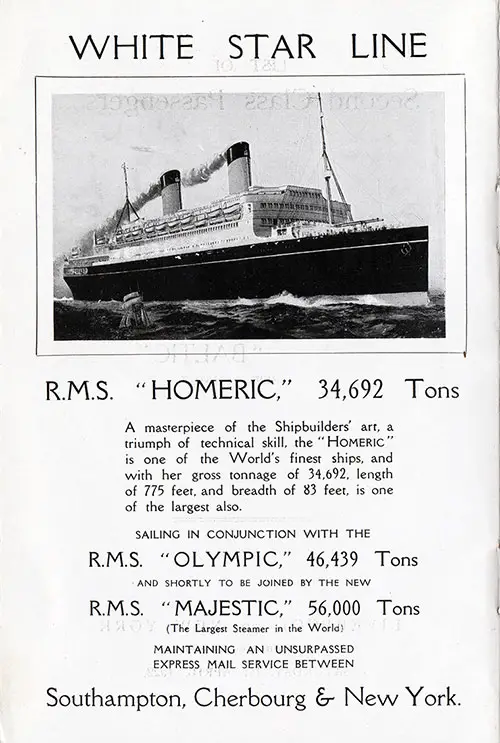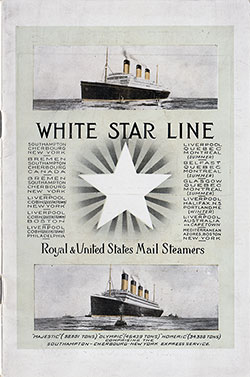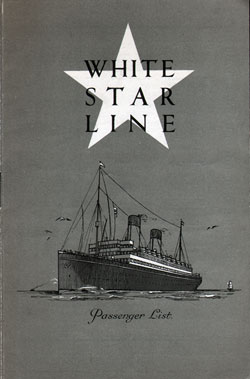RMS Homeric Passenger Lists 1923-1931

The RMS Homeric, 34,692 Tons, A masterpiece of the Shipbuilders' art, a triumph of technical skill, the "Homeric" is one of the World's finest ships and with her gross tonnage of 34,692, length of 775 feet, and breadth of 83 feet, is one of the largest also. RMS Baltic Passenger List, 1 April 1922. | GGA Image ID # 20b85860b9
All Digitized Passenger Lists For the RMS Homeric Available at the GG Archives. Listing Includes Date Voyage Began, Steamship Line, Vessel, Passenger Class and Route.
View Our RMS Homeric Archival Collection that Includes RMS Homeric (1914) White Star Line Ship's History (Brief); Passenger Lists; Illustrations and Paintings; Guides; Sailing Schedules; Route Maps, Track Charts, Abstract of Logs; Title Pages; Landing Instructions; Services; Wireless Technology; Time at Sea; Lights and Distances; Fleet List; Books; Advertisements; Other Ephemera; Officers Sleeve Stripes; Excerpts from Information for Passengers; Photographs; The New Steamship "Homeric" of the White Star Line (1922); and more.

1923-09-05 RMS Homeric Passenger List
Steamship Line: White Star Line
Class of Passengers: Second Class
Date of Departure: 5 September 1923
Route: Southampton to New York via Cherbourg
Commander: Captain F. B. Howarth (Cmdr., R.N.R.)

1925-04-04 SS Homeric Passenger List
Steamship Line: White Star Line
Class of Passengers: White Star Line
Class of Passengers: Second Class
Date of Departure: 4 April 1925
Route: New York to Southampton via Cherbourg
Commander: Captain J. Roberts, C.B.E., D.S.O., R.D. (Capt. R.N.R.)

1925-05-27 RMS Homeric Passenger List
Steamship Line: White Star Line
Class of Passengers: First Class
Date of Departure: 27 May 1925
Route: Southampton to New York via Cherbourg
Commander: Captain J. Roberts, C.B.E., D.S.O., R.D. (Capt. R.N.R.)

1926-08-25 RMS Homeric Passenger List
Steamship Line: White Star Line
Class of Passengers: Tourist Third Cabin
Date of Departure: 25 August 1926
Route: Southampton to New York via Cherbourg
Commander: Captain A. Holme

1928-08-08 RMS Homeric Passenger List
Steamship Line: White Star Line
Class of Passengers: Tourist Third Cabin
Date of Departure: 8 August 1928
Route: Southampton to New York via Cherbourg
Commander: Captain W. H. Parker

1929-09-18 RMS Homeric Passenger List
Steamship Line: White Star Line
Class of Passengers: Second Class
Date of Departure: 18 September 1929
Route: Southampton to New York via Cherbourg
Commander: Captain G. E. Warner, R.D. (Capt. R.N.R., Retd.)

1930-08-06 RMS Homeric First Class Passenger List
Steamship Line: White Star Line
Class of Passengers: First Class
Date of Departure: 6 August 1930
Route: Southampton to New York via Cherbourg
Commander: Captain J. B. Bulman

1930-08-06 RMS HomericTourist Third Cabin Passenger List
Steamship Line: White Star Line
Class of Passengers: Tourist Third Cabin
Date of Departure: 6 August 1930
Route: Southampton to New York via Cherbourg
Commander: Captain J. B. Bulman

1931-06-24 RMS Homeric Passenger List
Steamship Line: White Star Line
Class of Passengers: Tourist Third Cabin
Date of Departure: 24 June 1931
Route: Southampton to New York via Cherbourg
Commander: Captain J. B. Bulman
Passenger Lists contained in the GG Archives collection represent the souvenir list provided to the passengers of each cabin class (and other classes). Many of these souvenir passenger lists have disappeared over the years. Our collection contains a sampling of what was originally produced and printed by the steamship lines.
⚠️ About Accuracy in Historical Records Research Tip
Context. The GG Archives presents passenger lists as faithfully as possible to the original documents. While OCR is generally accurate, portions of these collections—especially image captions and some transcriptions—are typed by hand and may include typographical or spelling variations. The original manifests themselves also contained clerical inconsistencies (names recorded phonetically, mid-voyage corrections, etc.).
What this means for your research:
- Search variant spellings of names (e.g., “Schmidt/Schmitt/Smith,” “Giuseppe/Joseph”).
- Cross-reference with immigration cards, passport applications, naturalization files, city directories, and newspapers.
- Treat manifests as primary sources with historical quirks—use them alongside corroborating records.
- For place names, consider historical borders and language variants (e.g., Danzig/Gdańsk, Trieste/Trst).
How to cite. When quoting a name from a manifest, consider adding [sic] for obvious misspellings and include a note such as “spelling as printed in original passenger list.”
Need help? If you spot a likely transcription error in captions, feel free to contact us with the page URL and a brief note—we love community input. 🙏
Curator’s Note
For over 25 years, I've been dedicated to a unique mission: tracking down, curating, preserving, scanning, and transcribing historical materials. These materials, carefully researched, organized, and enriched with context, live on here at the GG Archives. Each passenger list isn't just posted — it's a testament to our commitment to helping you see the people and stories behind the names.
It hasn't always been easy. In the early years, I wasn't sure the site would survive, and I often paid the hosting bills out of my own pocket. But I never built this site for the money — I built it because I love history and believe it's worth preserving. It's a labor of love that I've dedicated myself to, and I'm committed to keeping it going.
If you've found something here that helped your research, sparked a family story, or just made you smile, I'd love to hear about it. Your experiences and stories are the real reward for me. And if you'd like to help keep this labor of love going, there's a "Contribute to the Website" link tucked away on our About page.
📜 History is worth keeping. Thanks for visiting and keeping it alive with me.
